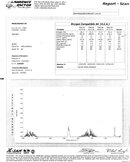I had two different Coz Ops send me test results from the main fill station after this thread started, in two different formats. I'll attach both, but I have come to think that they are worthless as the samples are possibly taken right after the filters are changed and when the compressors are first started, which is how I would do samples for public disclosure. Only an inline monitor really gives good info, and - I'm still going to check my tanks even if I see them filled then & there. The more I learn, the more I fear.
You'll notice that there were only 4 tests over 2 years at that...! :shocked2:
Don I think you highlighted one of the problems across the sport diving industry in that the frequency of air testing is woefully inadequate (it appears they only tested once in all of 2009) and typically the compressor operators sample under optimal conditions when the compressor is cold, and often only when the filters have just been changed out. Ideally they should be sampling only after the compressor has been brought up to full temperature at load and just before the filters are due to be changed. One can then be sure that the air quality meets the standard for the duration of the cartridge life.
Upon examining the LF results for the Cozumel central fill station one can say that they are generally not sampling immediately after the filter change as the carbon dioxide (CO2) values are close to ambient whereas typically immediately after a filter change they will be very low (i.e. < 100 ppm). The test #4 though was taken shortly after a filter change given the CO2 concentration at 218 ppm and ambient CO2 is approximately 380 ppm.
As you know if the air sample is taken only when the compressor is cold any lubricant oil dieseling due to overheating with subsequent CO production will not be picked up. I have attached portions of an article outlining this exact problem which occurred at the Montreal Fire Service in the 1990's. Fire fighters had been complaining of nausea and early fatigue while fighting fires despite being young and fit, and wearing their SCBA equipment. A researcher decided to check the SCBA bottles and found CO contamination at many fire halls (used a central compressor like on Coz) in the range of 1 to 250 ppm with the average being 60 ppm. :shocked2:
Upon further investigation they found that the " Bauer electric compressor" would only produce CO after it had been run at full load for
3 hours. This was determined by installing an inline CO monitor which showed the contamination as the compressor heated up to a point where the compressor oil auto-ignited or dieseled due to the excessive heat and poor ventilation.
Carbon monoxide and water vapor contamination of c... [J Toxicol Environ Health. 1997] - PubMed result
My guess is this is the same mechanism which explains what is happening at the central fill station in Cozumel, and until they install an inline CO monitor in order to verify that there is no CO produced throughout the entire compressor run cycle at full load those samples taken twice a year are meaningless and the risk of CO contamination still exists.
It may be even more complicated in that the only time their compressors will start dieseling the compressor oil is during the hot summer months and in the winter when the ambient temperature in the compressor room is cooler there is no CO produced.
Another factor is whether or not they are running a catalyst (Hopcalite) bed to convert any CO to less toxic CO2. The compressor say could produce CO contamination at the 3 hour mark but when the catalyst is dry it is able to remove the CO from the compressed breathing air. Towards the end of the cartridge life if the station is not monitoring their compressed air moisture levels the catalyst will become ineffective and allow the CO contamination into the breathing air. Catalyst requires extremely dry air in order to function effectively (i.e. dew point drier than -75 F).
Bottom line is that until this fill station installs inline CO monitors on its compressor system there is really no way to ensure that the contamination will not happen again. They could send a sample off to LF once a month and still not pick up the problem if it only occurs when the compressor is hot several hours into the duty cycle.
So you're right in that the individual diver should still carry some form of a personal CO protection device at all times.






 Hell, why do the dive Ops not have portable testers & 10 ppm calgas for testings?
Hell, why do the dive Ops not have portable testers & 10 ppm calgas for testings?
